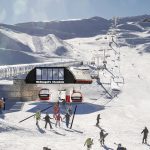DRIVING & ROAD CONDITIONS
Alpine Driving
Driving on New Zealand roads can be different to other countries, but generally in winter snow rarely falls low enough to cover the main highways. However ski area roads and mountain passes can be more challenging, as they can be icy or covered in snow from time to time. It’s essential that you know the road conditions before leaving your accommodation so you can plan your route and anticipate conditions along the way.
You should always check the latest updates from the New Zealand Transport Agency before you start your journey.
Roads
Nearly all roads to South Island ski areas are unpaved. The surface of the road can be loose and move under your wheels, meaning there is little skid resistance. If you’re not used to driving in gravel – take care and don’t rush.
The mountain resort staff work hard to keep the roads in good condition, but you may be faced with mud, ice and on occasion, snow. The teams are up early in the morning (well before sunrise) to assess the road, undertake any maintenance and provide you with a full report on current conditions. These guys are experienced and are literally on the spot. Resort websites will always provide the latest update on road conditions and so will majority of the accommodation providers, so it’s always a good idea to check with them too.
Driving to mountain resorts
Self-driving gives you flexibility and convenience, but also responsibility. You should always drive to the conditions and according to any instructions from mountain resort management and New Zealand traffic authorities. The conditions can change very quickly. Ice sometimes cannot be seen and snow can be difficult to drive in, if you’re not accustomed to it.
Always check the snow and road report for the ski area you are planning to visit. You will find that information on their website.
Chains
Most rental car companies will offer chains (sometimes for an extra fee) this time of the year. Make sure you include them in your booking, as you never know when you might need them to safely get around.
If you need to fit chains, due to snow and ice, here are some tips:
- Fit them at the assigned location where there is adequate space to do so.
- If you are not sure how to fit chains, have your rental car agency customer services staff provide you with information when you pick up your car, or if mountain staff are available, ask them.
- Usually you’ll be fitting chains when it is freezing cold, muddy and slushy. A useful tip is to take a ground-sheet and something to clean your hands with.
- Some ski areas provide staff that will put your chains on for a small fee – well worth it.
Organized transport
All ski resort towns have shuttles or buses to their nearby ski areas. The frequency and type of transport will vary, so it pays to check this out in advance. These vehicles are specifically suited to the alpine conditions and have drivers who are experienced in both the road conditions and the winter weather.
If you have any hesitation about driving in an alpine environment, organized transport is a good option.
Driving in New Zealand
If you’re interested in more information about driving in New Zealand in general – Drive Safe offers additional resources and tips, as well as sample itineraries.





